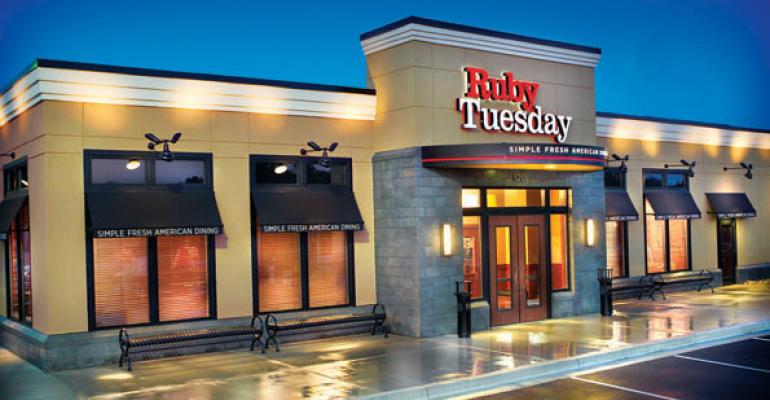Ruby Tuesday Inc.’s challenging year has resulted in several executive departures and heightened investor concern.
In October, the Maryville, Tenn.-based casual-dining chain saw the resignation of chairman Matthew Drapkin, who was replaced by president and chief executive James J. “JJ” Buettgen, and the reported departure of Robert LeBoeuf, senior vice president and chief people officer. The company did not return emails about LeBoeuf’s departure.
The executive departures came after the operator of 780 namesake casual-dining restaurants and several other concepts reported sales declines of 11.4 percent at company-owned locations and 8.4 percent at franchised units in the Sept. 3-ended first quarter.
RELATED
• Ruby Tuesday 1Q same-store sales decline 11.4%
• Ruby Tuesday chairman resigns
• More restaurant finance news
Drapkin is an activist shareholder who became involved in Ruby Tuesday in 2011 and a partner in Backer Drapkin Management, which last month liquidated its Ruby Tuesday holdings. His resignation led Bryan C. Elliott, an analyst with Raymond James & Associates, to reiterate an “under-perform” rating on the company’s stock.
“We believe Mr. Drapkin’s resignation from the board and his firm’s liquidation of its [Ruby Tuesday] holdings highlights the risks we continue to see,” Elliott said in a note.
And last week, Moody’s Investors Service of New York downgraded its rating for Ruby Tuesday and added that the chain was doing worse than the agency had expected. Moody’s lowered Ruby Tuesday’s corporate family rating one notch, to “B3” from “B2,” citing weak traffic trends, lowered consumer spending, and competition from promotions and discounts among other casual-dining chains.
“The downgrade is driven by operating performance that has been substantially weaker than Moody's prior expectations and deteriorating debt protection metrics,” Moody’s said in explaining its rationale.
The agency added that it also factored in weak same-store sales performance over the last few quarters and the expectation of continued pressures on same-store sales and traffic.
In its most recent quarter, the first of 2014, Ruby Tuesday’s net income decreased 7.7 percent, reflecting an 11.7-percent decline in revenue. For fiscal 2013, Ruby Tuesday reported a net loss of $39.4 million, or 65 cents per share, after revenue decreased 4.6 percent to $1.25 billion.
Buettgen, who joined Ruby Tuesday last December from his post as senior vice president and chief marketing officer at Orlando, Fla.-based Darden Restaurants Inc. and replaced retiring company founder Sandy Beall, conceded in a call with analysts that the results were disappointing.
“The first quarter was challenging from both a sales and profitability standpoint, as economic issues continue to provide significant headwinds at the macro level, and more specifically, within the restaurant industry,” he said. “The environment was very competitive, and combined with the broader economic challenges, the summer saw a slowdown in sales for the casual-dining segment.”
The 11.4-percent decline in same-store sales at company-owned units was driven by a guest-count drop-off of 10.5 percent and reduction in average check of about 1 percent, said Michael O. Moore, Ruby Tuesday’s chief financial officer.
Driving traffic through menu
(Continued from page 1)
Executives noted that the company is working to stabilize negative traffic trends. Buettgen said the company introduced “the first wave” of new products on Aug. 12, including four new pretzel burgers, three flatbreads and a tempura green bean appetizer. Those items, he said, were aimed at transforming Ruby Tuesday “into a more broadly appealing, vibrant and energetic brand, and to deliver more value and affordability to our guests.”
The pretzel burgers are priced between $8.99 and $9.49, the flatbreads are $6.99 and $7.99, and the green bean appetizer is $5.99.
“Within the categories that they're featured in, they're attractively priced items,” Buettgen explained.
The menu introductions, which were supported by six weeks of television advertising, including national cable, have been successful so far, he said.
“All of our new products immediately became popular with our guests, with over 20 percent of our guests ordering one of these eight new items within days of their introduction,” Buettgen said, noting that Ruby Tuesday will roll out additional menu items in phases throughout the remainder of the fiscal year.
Todd A. Burrowes, who joined Ruby Tuesday as chief operations officer and president of the concept in June, told analysts that the pretzel burgers and expanded appetizers represented a significant departure for the brand. The company is also working on service, he added.
“In the second quarter, we'll be testing an enhanced service platform that enables team members to share their personality and passion for our brand by connecting with guests in a more natural and genuine manner,” Burrowes told analysts.
Besides the casual-dining chain, Ruby Tuesday operates and franchises 24 locations of Lime Fresh Mexican Grill.
This story has been revised to reflect the following correction:
Correction: Nov. 15, 2013 An earlier version of this story referenced the incorrect quarter in the third paragraph.
Contact Ron Ruggless at [email protected].
Follow him on Twitter: @RonRuggless





